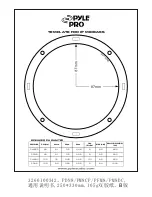
GOLDBERG AND MÄKIVIRTA
OPTIMISED EQUALISATION COMPARISON
AES 116TH CONVENTION, BERLIN, GERMANY, 2004 MAY 8-11
6
Similar trends are seen for the three-way systems
(Figure 11) except that the bass reduction averages –3
to –5 dB and some additional roll-off shape is seen at
the very lowest frequencies of the loudspeakers.
As there were only three large system responses
(Figure 12), all taken from same room, the standard
deviations indicate the equalisation consistency.
Across all of the loudspeakers (Figure 13), the general
trend is a need for approximately 3 dB to 4 dB of bass
attenuation, 2 dB from 200 Hz to 500 Hz and only 1
dB above 500 Hz. A 0 to –12 dB gain range is suffi-
cient. Across the whole study, only one of the third-
octave bands inside the optimisation frequency range
was set to the maximum attenuation, –12 dB.
The subband median levels (Figure 1) demonstrate
that a high median level in the LF subband is reduced
by the equalisation. This indicates that equalisation
compensates for acoustical loading of the loudspeaker.
The better match across subbands of the average sub-
band median level demonstrates that equalisation has
improved the broadband flatness, and the largest im-
provement is seen in the three-way and large systems.
The broadband flatness improvement is mainly the
result of better alignment of the LF subband with the
MF and HF subbands. The equalisation has reduced
the variation between subbands and also improved the
broadband flatness of the acoustical response. For all
loudspeakers pooled together, the equalisation reduces
the variance in the median level for the LF subband.
In Figure 14, Appendix E, the results are pooled for
all products and for each product type. The change in
quartile difference and RMS deviation for the broad-
band and the subbands is illustrated. For all models,
the broadband flatness is improved by 4.3 dB and the
mean reduction in the LF subband RMS deviation im-
provement is 5.9 dB. The graphic equaliser is able to
compensate, to some extent, the severe anomalies at-
tributable to extremely bad room acoustic conditions
seen within some of the pre-equalisation responses.
The average time taken for graphic equalisation
optimisation is 31.40 s ± 16.64 s. The best case is
14.61 s and the worst case is 116.29 s.
5.3. Equalisation Comparison
Appendix F, Figure 15, represents the difference be-
tween the change in sound level deviation due to the
room response controls and the graphic equalisation
techniques. For each subband, quartile difference and
RMS deviation from the median are plotted. A value
below 0 dB indicates that graphic equalisation
achieves a response closer to the target. For all loud-
speaker models pooled together, the room response
controls improved the RMS deviation from 6.1 dB to
4.7 dB (improvement 22%), whereas graphic equalisa-
tion improved the RMS deviation to 1.8 dB (im-
provement 70%). The main improvement is seen at
low frequencies. The better performance by the
graphic equaliser is achieved by using between five
(large loudspeakers) and ten times (small two-ways)
more equalisation stages and far longer optimisation
times.
The additional time it takes to perform the graphic
equalisation optimisation compared to room response
equalisation optimisation is 18.54 ± 8.49 times longer.
The best case is 8.35 times longer and the worst case
is 47.97 times longer.
6. DISCUSSION
The room response controls in active loudspeakers
implement discrete filter parameter values rather than
a continuous parameter value range. A 31-band
graphic equaliser typically allows for control of the
gain in each of the third-octave centred bands over a
range of ±12 dB and an overall make-up gain over the
same range. In this study the gains were constrained to
a range of 0 to –12 dB and a least squares optimisa-
tion algorithm designed for selecting the optimal set-
tings.
The statistical analysis of 67 in-situ loudspeaker re-
sponses shows that both equalisation methods achieve
a smaller RMS deviation from the target response.
The improvement is limited by the equalisers’ inabil-
ity to correct for narrow-band deviations in a magni-
tude response. There is little improvement in the quar-
tile differences and RMS deviations in the MF and HF
subbands. This is because room related response
variations are too narrow band to be corrected by a
third-octave graphic equaliser or the room response
control equaliser. The largest improvement is seen in
the three-way and large systems. This suggests that
better room acoustics, leading to a reduced loud-
speaker-room interaction, allows the equalisation
methods to operate more effectively.
The room response controls in the active loudspeakers
achieve a good broadband balance but the fine detail
is not corrected. Correcting fine detail may not be
very significant because human hearing is more sensi-
tive at detecting wideband imbalances than narrow
band deviations in the magnitude response [21, 22].
In an acoustically good room, the room response con-
trols built into an active loudspeaker allow for good
control of the broadband balance. A good example of
this can be seen in averaged median values of the
large systems (Figure 1) where the three responses
show good balancing and relatively little variance.
Even the three-way systems show a balancing within a
1.5dB window with relatively low variance. This is





































